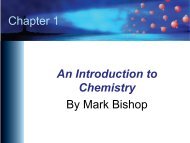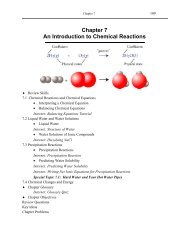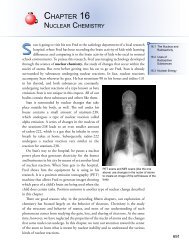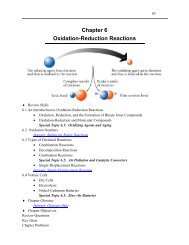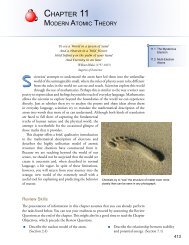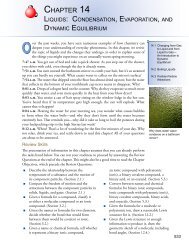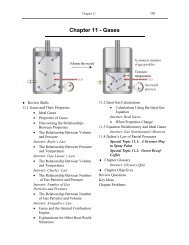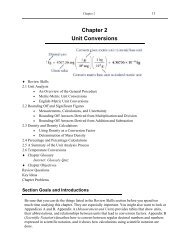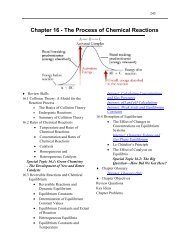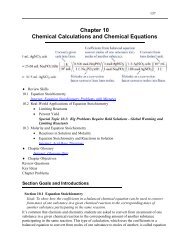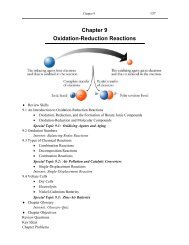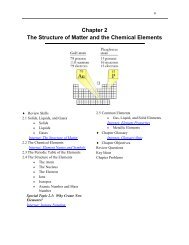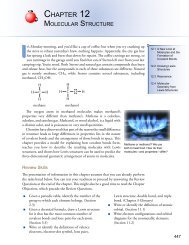Chapter 10 - An Introduction to Chemistry: Chemical Calculations ...
Chapter 10 - An Introduction to Chemistry: Chemical Calculations ...
Chapter 10 - An Introduction to Chemistry: Chemical Calculations ...
Create successful ePaper yourself
Turn your PDF publications into a flip-book with our unique Google optimized e-Paper software.
<strong>10</strong>.2 Real-World Applications of Equation S<strong>to</strong>ichiometry 381<br />
Example <strong>10</strong>.3 - Limiting Reactant<br />
Titanium carbide, TiC, is the hardest of the known metal carbides. It can be made by<br />
heating titanium(IV) oxide, TiO 2 , with carbon black <strong>to</strong> 2200 °C. (Carbon black is a<br />
powdery form of carbon that is produced when vaporized heavy oil is burned with<br />
50% of the air required for complete combustion.)<br />
TiO 2 + 3C → TiC + 2CO<br />
a. What is the maximum mass of titanium carbide, TiC, that can be formed from<br />
the reaction of 985 kg of titanium(IV) oxide, TiO 2 , with 500 kg of carbon, C?<br />
b. Why do you think the reactant in excess was chosen <strong>to</strong> be in excess?<br />
Objective 6<br />
Objective 7<br />
Solution<br />
a. Because we are given amounts of two reactants and asked <strong>to</strong> calculate an<br />
amount of product, we recognize this as a limiting reactant problem. Thus we<br />
first calculate the amount of product that can form from each reactant. The<br />
reactant that forms the least product is the limiting reactant and determines<br />
the maximum amount of product that can form from the given amounts of<br />
reactants.<br />
? kg TiC = 985 kg TiO 2<br />
1 × 59.878 kg TiC<br />
1 × 79.866 kg TiO 2<br />
= 738 kg TiC<br />
1 × 59.878 kg TiC<br />
? kg TiC = 500 kg C = 831 kg TiC<br />
3 × 12.011 kg C<br />
The limiting reactant is TiO 2 because it results in the least amount of product.<br />
b. We are not surprised that the carbon is provided in excess. We expect it <strong>to</strong><br />
be less expensive than titanium dioxide, and the excess carbon can be easily<br />
separated from the solid product by burning <strong>to</strong> form gaseous CO or CO 2 .<br />
Exercise <strong>10</strong>.2 - Limiting Reactant<br />
The uranium(IV) oxide, UO 2 , used as fuel in nuclear power plants has a higher<br />
percentage of the fissionable iso<strong>to</strong>pe uranium-235 than is present in the UO 2 found<br />
in nature. To make fuel grade UO 2 , chemists first convert uranium oxides <strong>to</strong> uranium<br />
hexafluoride, UF 6 , whose concentration of uranium-235 can be increased by a process<br />
called gas diffusion. The enriched UF 6 is then converted back <strong>to</strong> UO 2 in a series of<br />
reactions, beginning with<br />
UF 6 + 2H 2 O → UO 2 F 2 + 4HF<br />
a. How many megagrams of UO 2 F 2 can be formed from the reaction of 24.543<br />
Mg UF 6 with 8.0 Mg of water?<br />
b. Why do you think the reactant in excess was chosen <strong>to</strong> be in excess?<br />
Objective 6<br />
Objective 7



